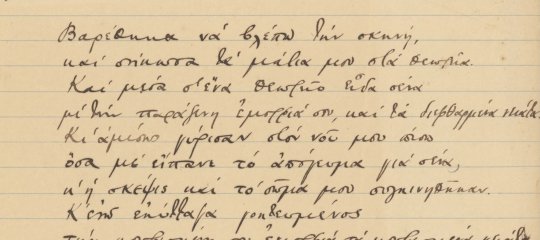Οικονομικό Παν/μιο της Σμύρνης: αρχάριοι ΙΙΙ (Μαρία Βλάχου)
ΠΑΝΕΠΙΣΤΗΜΙΟ ΟΙΚΟΝΟΜΙΚΩΝ ΤΗΣ
ΣΜΥΡΝΗΣ
GRK 102 ΜIDTERM
11/04/2007
Όνομα:
Επίθετο:
|
¶σκηση |
Α |
Β |
Γ |
Δ |
Ε |
Ζ |
Η |
Θ |
Ι |
Κ |
Λ |
|
Βαθμοί |
15 |
6 |
6 |
6 |
5 |
10 |
20 |
6 |
6 |
11 |
9 |
|
Σύνολο |
|||||||||||
|
Βαθμοί 100 Σύνολο |
|||||||||||
A. Διάβασε το κείμενο και απάντησε στις
ακόλουθες ερωτήσεις:
(2Χ5=10)
Ο Σωτήρης είναι δικηγόρος και μένει με την Όλγα, την
φίλη του. Η Όλγα δουλεύει σε ένα βιβλιοπωλείο. Μένουν στη
Θεσσαλονίκη, κοντά στο κέντρο. Δεν έχουν παιδιά. Ο Σωτήρης
κάθε μέρα ξυπνάει στις εφτά, πίνει έναν καφέ, τρώει μια
τυρόπιτα και πάει με το αυτοκίνητο στο γραφείο του. Η Όλγα
ξυπνάει στις οκτώ και δεν τρώει πρωινό, πίνει μόνο ένα
τσάι. Ανοίγει το βιβλιοπωλείο στις οκτώ και μισή. Δεν πάει
με το αυτοκίνητο γιατί το μαγαζί είναι πολύ κοντά στο
σπίτι. Το μεσημέρι ο Σωτήρης τρώει στη δουλειά. Η Όλγα το
απόγευμα δε δουλεύει. Κλείνει το βιβλιοπωλείο στις τρεις
και πάει σπίτι. Ετοιμάζει (prepares) φαγητό και μετά
συνήθως ακούει μουσική και διαβάζει. Ο Σωτήρης τελειώνει
στις πέντε το απόγευμα. Πηγαίνει σπίτι κι όταν είναι
κουρασμένος κοιμάται για μια ώρα. Το βράδυ συνήθως βλέπουν
τηλεόραση ή παίζουν τάβλι. Το σαββατοκύριακο συχνά πάνε
σινεμά, θέατρο ή για φαγητό σε μια ωραία ταβέρνα με την
παρέα τους.
1. Τι ώρα ξυπνάει ο Σωτήρης το πρωί;
.........................................................
2. Τι τρώει για πρωινό η Όλγα;
.........................................................
3. Γιατί η Όλγα δεν πάει με το αυτοκίνητο στο
βιβλιοπωλείο;
.........................................................
4. Τι ώρα φεύγει ο Σωτήρης από τη δουλειά;
.........................................................
5. Που πάνε το σαββατοκύριακο;
.........................................................
Απάντησε Σωστό ή Λάθος:
(1X5=5)
Σ Λ
1.Ο Σωτήρης τρώει βραδινό στη δουλειά
.... ....
2. Η Όλγα πίνει μόνο ένα τσάι το πρωί.
.... ....
3. Το βιβλιοπωλείο ανοίγει στις εννιά.
.... ....
4. Ο Σωτήρης πάει στη δουλειά με το αυτοκίνητο.
.... ....
5. Το βράδυ βλέπουν τηλεόραση και παίζουν
σκάκι. .... ....
Β. Γράψε το σωστό:
(1Χ6=6)
1.Το εστιατόριο είναι
δίπλα............................... ταβέρνα.
2.Η τράπεζα είναι μπροστά............................
περίπτερο.
3.Το ταχυδρομείο είναι
κοντά...........................σπίτι μου
4.Το σινεμά είναι πίσω...............................
φούρνο.
5.Ο Γιώργος μένει πολύ μακριά.........................
κέντρο
6. Ο μανάβης είναι απέναντι .........................ταβέρνα «Το
Στέκι».
Γ. Γράψε την ώρα:
(1Χ6=6)
1. 5:15 .........................
2. 10: 20 .........................
3. 20: 30 .........................
4. 1: 10 .........................
5. 3:00 .........................
6. 15:45 .........................
Δ. Γράψε τις μέρες της εβδομάδας:
(1Χ6=6)
Κυριακή
................
................
................
................
................
................
Ε. Βάλε τόνο όπου χρειάζεται:
(5)
Με λενε Νικο. Ειμαι ιταλος αλλα μενω στην Αθηνα. Ειμαι
φοιτητης στο Πανεπιστημιο και σπουδαζω κινηματογραφο. Ο
πατερας μου δουλευει σε μια τραπεζα και η μητερα μου ειναι
γιατρος.
Z. Διάλεξε το σωστό:
(1X10=10)
1. ................ χρονών είναι η καθηγήτριά σας;
Α. Πόσο Β. Πως Γ. Πόσω
2. Μήπως ξέρετε................ώρα είναι τώρα;
Α. Τι Β. Πότε Γ. Που
3. Το παιδί τους είναι ................ χρονών.
Α. δεκατρία Β. δεκατριών Γ.
δεκατρείς
4. Από ................ είναι η Νουράν;
Α. που Β. ποιο Γ. τι
5. Δεν ξέρω................ λένε αυτή την οδό.
Α. ποια Β. πόσο Γ. πως
6. ................μαθαίνετε ελληνικά;
Α. τι Β. ποιος Γ. που
7. Η τράπεζα είναι κλειστή ................ Κυριακή.
Α. η Β. την Γ. στην
8. Η πιτσαρία είναι ανοιχτή από................εφτά ως ................
δώδεκα το βράδυ.
Α. στις/ στις Β. τις/τις Γ. στις/
τις
9. Έχω ραντεβού με τον Βασίλη ................ μια και μισή το
μεσημέρι.
Α. στη Β. στις Γ. τη
10. ......................είναι αυτή η κυρία;
Α. Ποια Β. Ποιο Γ.
ποιος
H. Βάλε τα ρήματα στον σωστό
τύπο:
(1Χ20=20)
1. Εμείς δεν έχουμε αυτοκίνητο γιατί δεν ξέρουμε να
................(oδηγώ)
2. Η ¶ντα ................................... συχνά στο
παιδί της. (τηλεφωνώ)
3. Ο Νίκος δεν.................................. τί ώρα
είναι το ραντεβού. (θυμάμαι)
4. ...................................... αλλά το
Σάβατο έχω δουλειά. (λυπάμαι)
5. Ελένη .................................. να πας στο
πάρτι σήμερα το βράδυ; (μπορώ)
6. Ο Αλέκος και η Γιάννα
.................................. μαζί (ζω)
7. Εμεις ..................................... πολύ
νωρίς (κοιμάμαι)
8. Αυτοί δεν .......................................
ποτέ στο μάθημα. (αργώ)
9. Γιάννη, .................................... γαλλικά;
(μιλάω)
10. Η Ντίνα .........................................
από το σχολείο. (έρχομαι)
11. Εγώ και η Κάτια .......................... πάντα ένα
μπισκότο για πρωινό. (τρώω)
12. Ο Χάρης ............................. σήμερα το
βράδυ για το Παρίσι. (φεύγω)
13. Η τράπεζα ................................. στις
οκτώ και μισή. (ανοίγω)
14. Εγώ ................................... στο
Κολωνάκι, εσύ; (μένω)
15. Το μπαρ ................................... στις
τρεις. (κλείνω)
16. Εσείς τι ώρα
......................................τη δουλειά;
(τελειώνω)
17. Το μάθημα μας ....................................
στις πέντε. (αρχίζω)
18. Αυτοί ........................................ πάντα
αργά. (ξυπνάω)
19. Εσύ ................................... τον σεισμό;
(φοβάμαι)
20. Τι ..................................... Αναστασία;
(σκέφτομαι)
Θ. Κοίταξε το πρόγραμμα του Μιχάλη και συμπλήρωσε τα
κενά: (1Χ6=6)
Χρησιμοποίησε πάντα, συνήθως,
συχνά, καμιά φορά, σπάνια,
ποτέ.
Σ. πρ/ σπίτι Κ. πρ/σπίτι
Δ. πρ/ σχολείο Τ. πρ/σχολείο
Σ. μες/ καφέ Κ. μες/ καφέ
Δ. μεσ/ σπίτι Τ. μεσ/ σπίτι
Σ. απ/ μπιλιάρδο Κ. απ/ σπίτι
Δ. απόγ/ μπάσκετ Τ. απογ. σπίτι
Σ. βρ/ μπαρ Κ. βρ/ ταβέρνα Δ.
βρ/ σπίτι Τ. βρ/ σινεμά
1. Το βράδυ ................ πάει σινεμά.
2. Τη Δευτέρα το πρωί .................πάει στο σχολείο.
3. Το απόγευμα ................ μένει στο σπίτι.
4. Το μεσημέρι ................πάει για καφέ.
5. Το πρωί ................ δεν πάει για μπιλιάρδο.
6. ................παίζει μπάσκετ.
I. Γράψε τα αντίθετα:
(1X6=6)
Ωραίος ............ Κλείνω ............
Παλιό ............ Ξυπνάω ............
Νωρίς ............ Πάω ............
K. Βάλτε την αντωνυμία (κανένας,
καμία,κανένα) και το αόριστο άρθρο (ένας,
μια, ένα) στην ονομαστική ή στην
αιτιατική:
(1Χ11=11)
1.Υπάρχει........................... φούρνος εδώ
κοντά;
2. Ξέρεις.............................καλό γιατρό;
3. Θέλω ..........................καφέ με
..................... κουταλάκι ζάχαρη.
4. Έχεις ........................σοκολάτα;
Ναι, αλλά έχω μόνο …….....................
5. Εμείς θέλουμε ........................... παγωτό.
6. Υπάρχει ……………….…….τράπεζα εδώ κοντά;
Δεν υπάρχει .................................
7. Θα ήθελα ..............................
κατάλογο,παρακαλώ.
8. Εμείς δεν έχουμε ……………….. παιδί.
Λ. Απάντησε στις ερωτήσεις
(1.5Χ6=9)
1. Τι ώρα ξυπνάς το πρωί;
.......................................................................................
2. Τι τρως για πρωινό;
........................................................................................
3. Πως πας στο πανεπιστήμιο;
........................................................................................
4. Το σαββατοκύριακο που πας όταν βγαίνεις έξω;
........................................................................................
5. Το βράδυ τι ώρα κοιμάσαι συνήθως;
.........................................................................................
6. Σου αρέσει το μάθημα των ελληνικών;
...........................................................................................










